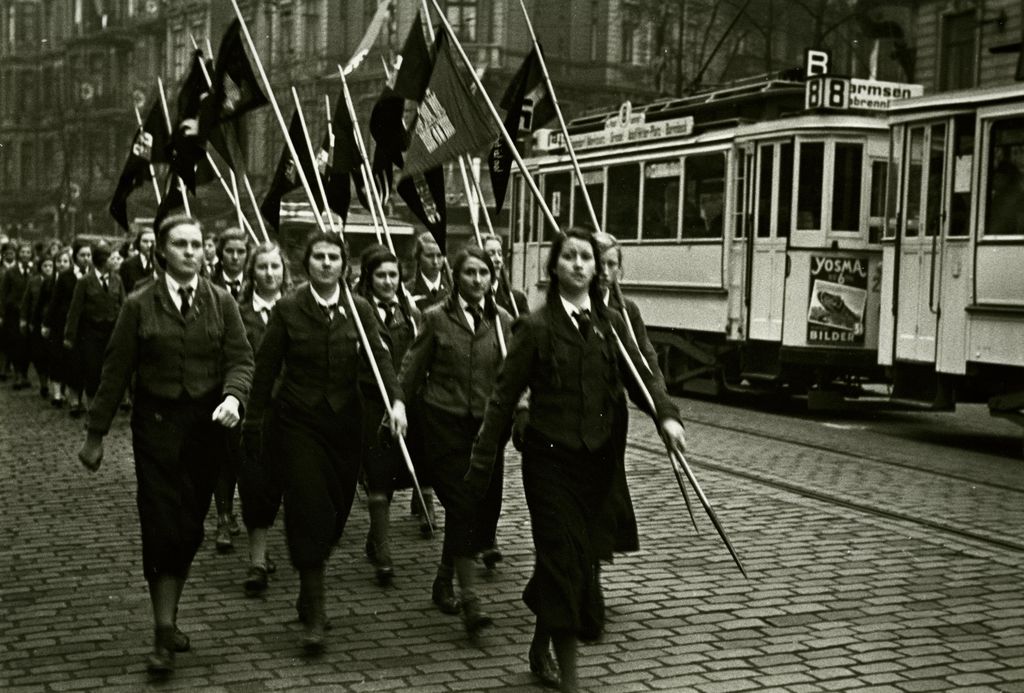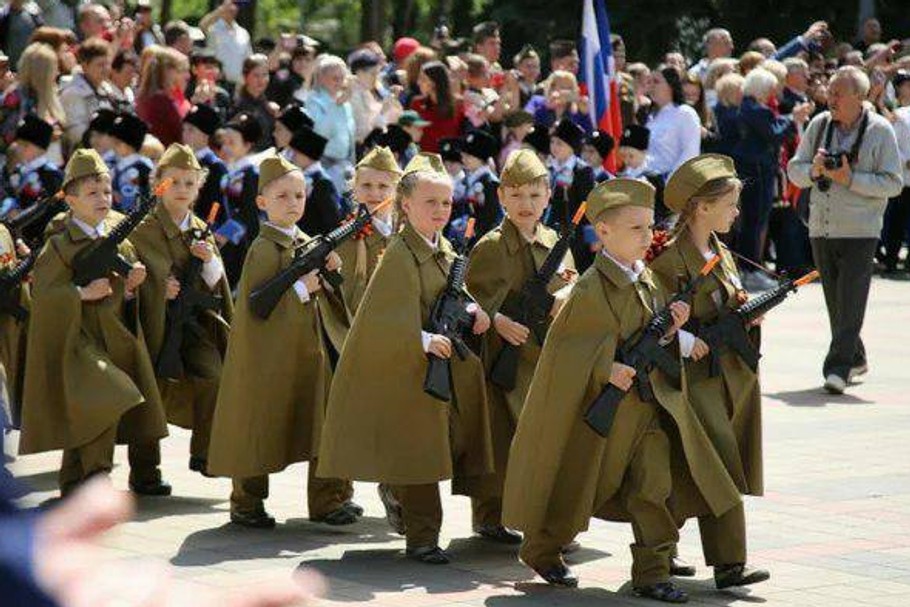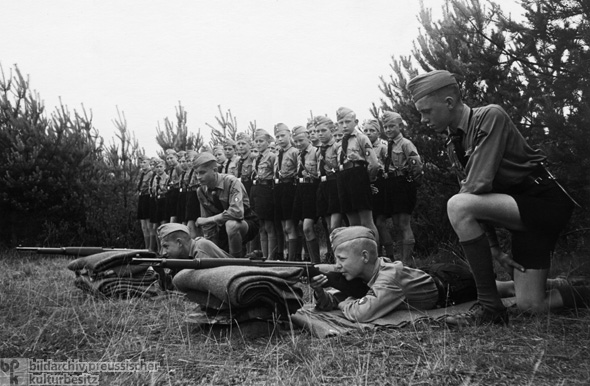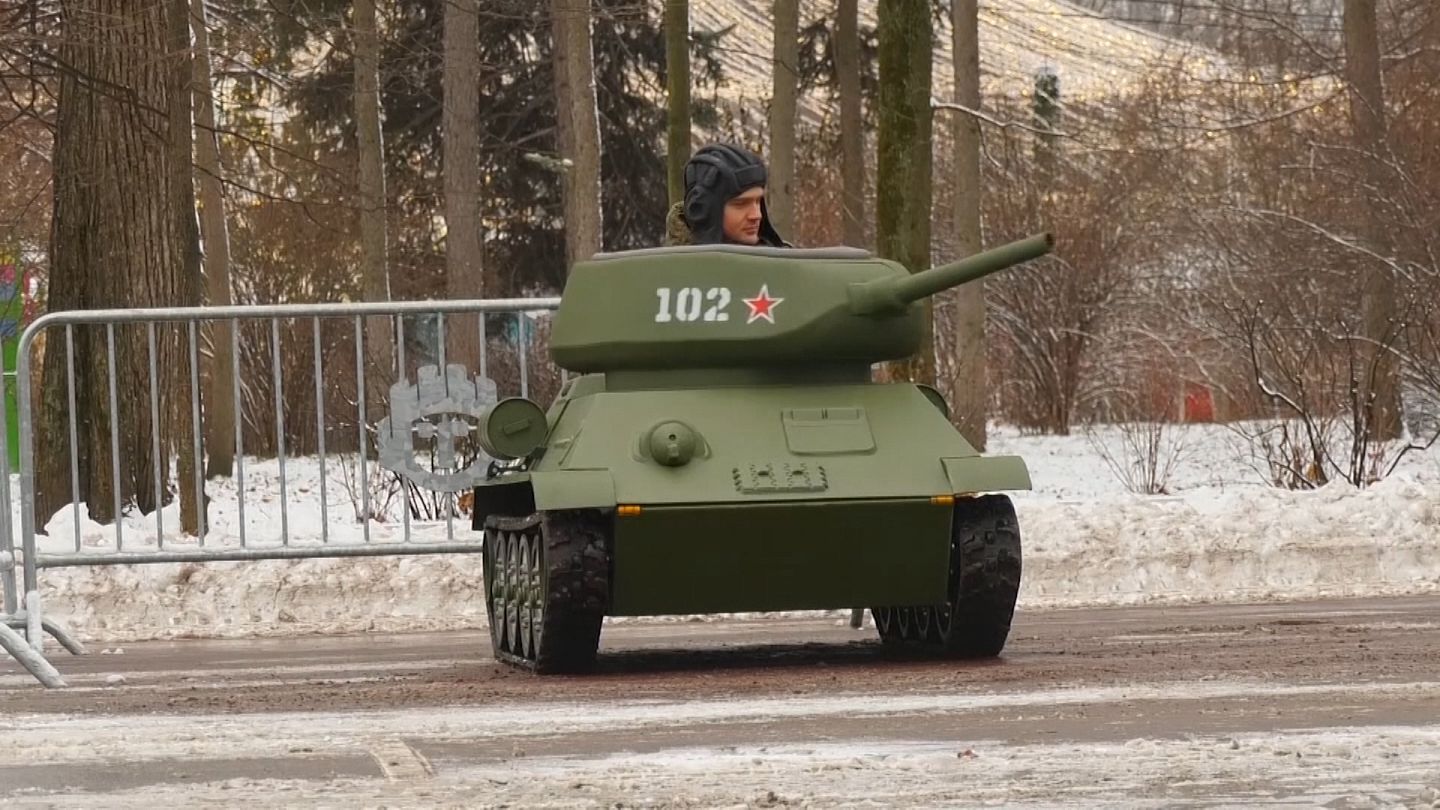|
|
Post by pjotr on May 23, 2019 23:59:48 GMT 1
Polish high school uniform classes are a piece of cake compared to Russian ones:  Girls of the Bund Deutscher Mädel in Nazi Germany Girls of the Bund Deutscher Mädel in Nazi Germany Bund Deutscher Mädel Aufmarsch in Hamburg, 1934 in Nazi Germany Bund Deutscher Mädel Aufmarsch in Hamburg, 1934 in Nazi Germany Bund Deutscher Mädel in 1938 Bund Deutscher Mädel in 1938 |
|
|
|
Post by pjotr on May 24, 2019 0:05:57 GMT 1
Even Russian kindergarten kids are armed. Mock rifles, but soon it will change.  We need sth like that in Poland, too. Our kindergarten kids aren`t patriotic enough, they only want to play.  Deutsches Jungvolk in der Hitler Jugend Deutsches Jungvolk in der Hitler Jugend  Military drill for members of the Deutsches Jungvolk Military drill for members of the Deutsches Jungvolk |
|
|
|
Post by Bonobo on Jun 13, 2019 18:05:37 GMT 1
These Russian girls remind me of the Bund Deutscher Mädel of Nazi Germany Bonobo. [/font] [/quote] Of course. The Third Reich wanted to conquer all the world and the Soviet Union, whose heritage was taken over by Russia, too. It is natural you can`t carry out such a deed on your own, you need troops. |
|
|
|
Post by Bonobo on Aug 14, 2019 13:44:41 GMT 1
Even Russian kindergarten kids are armed. Mock rifles, but soon it will change. We need sth like that in Poland, too. Our kindergarten kids aren`t patriotic enough, they only want to play. I was joking but it appears Polish kids can have a little similar experiences - they can participate in a camp reenacting WW2 partisan life. Hmm, not a bad idea. warszawa.wyborcza.pl/warszawa/5,54420,25032551.html#S.MT_wawa-K.C-B.3-L.1.maly     |
|
|
|
Post by jeanne on Aug 15, 2019 23:56:43 GMT 1
Even Russian kindergarten kids are armed. Mock rifles, but soon it will change. We need sth like that in Poland, too. Our kindergarten kids aren`t patriotic enough, they only want to play. I was joking but it appears Polish kids can have a little similar experiences - they can participate in a camp reenacting WW2 partisan life. Hmm, not a bad idea. I'm sure that as a teacher you know for certain that "hands-on" is the best way to learn a concept!  |
|
|
|
Post by Bonobo on Nov 1, 2019 9:51:35 GMT 1
This reminds me of the Deutsches Jungvolk in der Hitler Jugend
Yes, but I read an article that the contemporary youth who is mostly lost in search for positive examples need clear and strong authority to believe in and follow - they don`t want lukewarm ones without charisma because they aren`t attractive enough to them. A question arises: should they be allowed to be influenced by strong authority with the probability of becoming brainwashed in the wrong direction or rather let alone with the danger of their turning to brainless activities on their phones, experiments with drugs and other stupid stuff? |
|
|
|
Post by Bonobo on Jan 1, 2020 20:50:31 GMT 1
Burning cars parked in streets has always been a strange tradition in certain countries, e.g, France. Not only during demonstrations but also during holidays, like New Year`s Eve. 200 cars burnt last night. Nice. In Poland cars are burned rarely, mostly by mental guys with arson obsession. www.thelocal.fr/20191231/is-the-famous-french-tradition-of-torching-cars-dying-out 
Why are hundreds of cars burned in France on New Year's Eve?
Burning cars is something of a tradition in France, albeit a much hated one by authorities and car owners, and it appears to be on the rise again.
Every New Year’s Eve nervous car owners across France cross their fingers in the hope they can start the New Year with their vehicle intact.
That’s because of a longstanding French tradition that sees youths in certain parts of cities torching scores of cars.
The number of vehicles set alight on the night of December 31st 2018 climbed to 1,031 compared to 935 the previous New Year's Eve, while arrests rose from 456 to 510, the interior ministry said on Monday.
Nevertheless stats released last year by France’s official crime data agency ONDRP reveal that the number of cars burned each year has fallen by 20 percent since 2010.
That was the good news for car owners and insurance firms.
The bad news is that tens of thousands of vehicles are still burned across the country.
The main burning season is in July and August, particularly on Bastille Day on July 14th when youths mark the annual fête nationale with their own firework shows.
The main reason for the fall according to the ONDRP is that the media take less interest now in the mass burning of cars, which means there may be less of a thrill for the arsonists.
|
|
|
|
Post by pjotr on Jan 2, 2020 0:08:22 GMT 1
|
|
|
|
Post by pjotr on Jan 2, 2020 0:21:06 GMT 1
A good start of the Year in the Netherlands
|
|
|
|
Post by naukowiec on Jan 2, 2020 13:18:25 GMT 1
a strange tradition in certain countries, e.g, France. Wow! Never seen anything like that before. What a strange way to spend New Year's Eve, torching cars. It happens here occasionally, but usually to cover up a crime or by gangs of bored youths. A garage is a necessity in France on NYE then! |
|
|
|
Post by Bonobo on Feb 26, 2020 10:44:13 GMT 1
In my English textbooks for kids we frequently run into health issues. One of pieces of advice that is given to people suffering from common cold/flu etc is to have some hot soup. They even add pictures to illustrate it.
That`s funny, it is not mentioned as a remedy at all here.
|
|
|
|
Post by naukowiec on Feb 26, 2020 22:09:59 GMT 1
it is not mentioned as a remedy at all here. I've not heard of that one at all. I've heard of having hot lemon drinks or a hot toddy ( more of a Scottish and Irish thing ), but not soup. Maybe it was common in days gone by, or maybe regional. |
|
|
|
Post by Bonobo on Feb 27, 2020 13:42:35 GMT 1
it is not mentioned as a remedy at all here. I've not heard of that one at all. I've heard of having hot lemon drinks or a hot toddy ( more of a Scottish and Irish thing ), but not soup. Maybe it was common in days gone by, or maybe regional. That book is Welcome series from 2000. I will try to look for images from it to show you. |
|
|
|
Post by naukowiec on Feb 29, 2020 19:42:37 GMT 1
I would be interested to see that. Certainly no-one has ever suggested to me that I should have soup to go with a cold! I'll ask at work if anyone else has heard that.
|
|
|
|
Post by Bonobo on Mar 1, 2020 21:52:51 GMT 1
I would be interested to see that. Certainly no-one has ever suggested to me that I should have soup to go with a cold! I'll ask at work if anyone else has heard that. See below: Because they don`t read textbooks for foreign kids or online advice: www.sharecare.com/health/cold-and-flu/why-chicken-soup-have-coldAttachments:
|
|
|
|
Post by naukowiec on Mar 3, 2020 20:29:03 GMT 1
Aha. So it's not just soup, but chicken soup! Better the hot toddy, a few of those and the cold is forgotten  |
|
|
|
Post by Bonobo on Mar 5, 2020 12:36:05 GMT 1
Aha. So it's not just soup, but chicken soup! Better the hot toddy, a few of those and the cold is forgotten  It is any soup in the textbook while my link is about chicken soup.  |
|
|
|
Post by jeanne on Mar 15, 2020 1:47:57 GMT 1
Aha. So it's not just soup, but chicken soup! Better the hot toddy, a few of those and the cold is forgotten  It is any soup in the textbook while my link is about chicken soup.  It's true, on this side of the pond, chicken soup is the go-to remedy for whatever ails you...especially colds, flu, etc. |
|
|
|
Post by Bonobo on Mar 21, 2020 10:24:22 GMT 1
It's true, on this side of the pond, chicken soup is the go-to remedy for whatever ails you...especially colds, flu, etc. Is it also so in your area? When I read stories about past times, I often run into mention of giving weak or ill people some fattening stock. |
|
|
|
Post by jeanne on Mar 21, 2020 14:43:41 GMT 1
It's true, on this side of the pond, chicken soup is the go-to remedy for whatever ails you...especially colds, flu, etc. Is it also so in your area? Yes, it is! No doubt chicken stock...  |
|
|
|
Post by Bonobo on Mar 22, 2020 9:04:58 GMT 1
No doubt chicken stock...  Rather beef stock. |
|
|
|
Post by jeanne on Mar 22, 2020 12:16:29 GMT 1
No doubt chicken stock...  Rather beef stock. I guess that would be more fattening...but then the broth would be without what makes chicken soup the "magical" cure! |
|
|
|
Post by Bonobo on Apr 2, 2020 11:57:52 GMT 1
I guess that would be more fattening...but then the broth would be without what makes chicken soup the "magical" cure! I have just had a lesson from our new textbooks published in 2019 and there is a mention of hot soup as good for yuor health in a text about health tips. It even suggests hot soup can kill viruses. |
|
|
|
Post by jeanne on Apr 2, 2020 21:45:35 GMT 1
I guess that would be more fattening...but then the broth would be without what makes chicken soup the "magical" cure! I have just had a lesson from our new textbooks published in 2019 and there is a mention of hot soup as good for yuor health in a text about health tips. It even suggests hot soup can kill viruses. Well, there you go! Get out the soup pot and get cooking! |
|
|
|
Post by Bonobo on Jun 16, 2020 17:16:03 GMT 1
I have just had a lesson from our new textbooks published in 2019 and there is a mention of hot soup as good for yuor health in a text about health tips. It even suggests hot soup can kill viruses. Well, there you go! Get out the soup pot and get cooking! Yes, I do it once a week. |
|
|
|
Post by Bonobo on Nov 4, 2020 11:59:37 GMT 1
Polish voivodships  vs American States  What is the main difference? |
|
|
|
Post by Bonobo on Dec 30, 2021 13:01:51 GMT 1
Even Russian kindergarten kids are armed. Mock rifles, but soon it will change. Coming back to military atmosphere prevailing in Russia, a patriotic theme park offers such attractions:   We need more of that in Poland, too. Russians fear that anybody or anything might try to attack their country any time so they never cease to prepare for a deadly fight. Poles are too relaxed coz they fear nothing. www.nytimes.com/2021/12/21/world/europe/russia-military-putin-kremlin.html
How the Kremlin Is Militarizing Russian Society
With a “youth army,” a cathedral honoring the military and state media promoting patriotism, the government is preparing Russians for the possibility of a fight.
A patriotic mural showing Soviet pilots from World War II, based on a photograph of the Victory Parade in 1945. The sign in Russian reads, “The saved world remembers you!”Credit...
By Anton Troianovski, Ivan Nechepurenko and Valerie HopkinsPhotographs by Sergey Ponomarev
Dec. 21, 2021
阅读简体中文版閱讀繁體中文版
MOSCOW — Stepping onto a podium in heavy boots and military fatigues at a ceremony outside Moscow, six teenagers accepted awards for an increasingly important discipline in Russia: patriotism.
For days, students from around the country had competed in activities like map-reading, shooting and history quizzes. The contest was funded in part by the Kremlin, which has been making “military patriotic” education a priority.
“Parents and children understand that this aggressive shell around us, it is tightening, it is hardening,” said Svyatoslav Omelchenko, a special forces veteran of the K.G.B. who founded Vympel, the group running the event. “We are doing all we can to make sure that children are aware of that and to get them ready to go and serve.”
Over the past eight years, the Russian government has promoted the idea that the motherland is surrounded by enemies, filtering the concept through national institutions like schools, the military, the news media and the Orthodox Church. It has even raised the possibility that the country might again have to defend itself as it did against the Nazis in World War II.
Now, as Russia masses troops on the Ukrainian border, spurring Western fears of an impending invasion, the steady militarization of Russian society under President Vladimir V. Putin suddenly looms large, and appears to have inured many to the idea that a fight could be coming.
“The authorities are actively selling the idea of war,” Dmitri A. Muratov, the Russian newspaper editor who shared the Nobel Peace Prize this year, said in his acceptance speech in Oslo this month. “People are getting used to the thought of its permissibility.”
Speaking to Russian military leaders on Tuesday, Mr. Putin insisted that Russia did not want bloodshed, but was prepared to respond with “military-technical measures” to what he described as the West’s aggressive behavior in the region.
While there is no surging war fever taking hold, there are plenty of signs that the government has been nurturing a readiness for conflict. A $185 million four-year program started by the Kremlin this year aims to drastically increase Russians’ “patriotic education,” including a plan to attract at least 600,000 children as young as 8 to join the ranks of a uniformed Youth Army. Adults get their inculcation from state television, where political shows — one is called “Moscow. Kremlin. Putin.” — drive home the narrative of a fascist coup in Ukraine and a West bent on Russia’s destruction.
And all are united by the near-sacred memory of Soviet victory in World War II — one that the state has seized upon to shape an identity of a triumphal Russia that must be ready to take up arms once more.
Aleksei Levinson, the head of sociocultural research at the Levada Center, an independent Moscow pollster, calls the trend the “militarization of the consciousness” of Russians. In the center’s regular surveys, the army in 2018 became the country’s most trusted institution, surpassing even the president. This year, the share of Russians saying they feared a world war hit the highest level recorded in surveys dating to 1994 — 62 percent.
This does not mean, Mr. Levinson cautioned, that Russians would welcome a bloody territorial conquest of Ukraine. But it does mean, he said, that many have been conditioned to accept that Russia is locked in an existential rivalry with other powers in which the use of force is a possibility.
Celebration of the Soviet Union’s victory over Nazi Germany in World War II — referred to as the Great Patriotic War in Russia — has played the most important role in that conditioning. Rather than promoting only a culture of remembrance of Soviet heroism and 27 million lives lost, the Kremlin applies the World War II narrative to the present day, positioning Russia as once again threatened by enemies bent on its destruction.
A popular World War II bumper sticker reads, “We can do it again.”
“There’s a transposition taking place of this victory” — in World War II — “into the present-day confrontation with the NATO bloc,” Mr. Levinson said.
One hour west of Moscow, the grand Cathedral of the Russian Armed Forces opened last year. Its exterior is army green and its floors are made from weapons and tanks seized from the German Wehrmacht. Arched stained glass windows feature insignia and medals.
On a recent Sunday, the church and its accompanying museum and park were full of visitors. A group of fifth graders from the Suvorov Military School in Tver, wearing their uniforms, filed out in two lines before marching to the museum. Their instructor said it was fundamentally important for the students, in their first year of military school, to learn about their predecessors.
“We’re doing a bit of propaganda, too,” the section leader quipped, declining to give his name.
Beyond the church grounds, visitors walked among snow-covered trenches in a simulated front line. Further afield, under the towering dome of the church, children could ride around a go-kart like track in a miniature replica of a battle tank.
“All children should come here and develop an interest in history from an early age,” said Alina Grengolm, as her 2-year-old son scrambled up an icy tank with his father’s assistance.
In Moscow recently, more than 600 people from across Russia gathered for a government-sponsored forum aimed at promoting patriotism among youth. Sergei Kiriyenko, Mr. Putin’s powerful deputy chief of staff, praised the attendees for doing “sacred work.”
Understand Russia’s Relationship With the West
The tension between the regions is growing and Russian President Vladimir Putin is increasingly willing to take geopolitical risks and assert his demands.
Competing for Influence: The threat of confrontation is growing in a stretch of Europe from the Baltic Sea to the Black Sea.
Threat of Invasion: As the Russian military builds its presence near Ukraine, the United States is cautiously moving to support Kyiv.
Energy Politics: An explosion in gas prices in Europe has led to accusations that the Kremlin is restricting gas supplies for political purposes.
Migrant Crisis: As people gathered on the eastern border of the European Union, Russia's uneasy alliance with Belarus triggered additional friction.
Militarizing Society: With a “youth army” and initiatives promoting patriotism, the Russian government is pushing the idea that a fight might be coming.
In a Levada poll published last week, 39 percent of Russians said war between Russia and Ukraine was either inevitable or very likely. Half said the United States and NATO were to blame for the recent rise in tensions, and no more than 4 percent — across all age groups — said Russia was at fault.
The conviction across society that Russia is not the aggressor reflects a core ideology dating to Soviet times: that the country only fights defensive wars. The government has even earmarked money for movies that explore that theme: In April, the Culture Ministry decreed that “Russia’s historical victories” and “Russia’s peacekeeping mission” were among the priority topics for film producers seeking government funding.
“Right now, the idea is being pushed that Russia is a peace-loving country permanently surrounded by enemies,” said Anton Dolin, a Russian film critic. “This is contradicted by some facts, but if you show it at the movies and translate that idea into the time of the Great Patriotic War, we all instantly get a scheme familiar to everyone from childhood.”
On Russian state television, the narrative of a Ukraine controlled by neo-Nazis and used as a staging ground for Western aggression has been a common trope since the pro-Western revolution in Kyiv in 2014. After the revolution, Russia annexed the Ukrainian peninsula of Crimea, fomented a war in Ukraine’s east and sharpened its messaging about Russia as a “besieged fortress.”
Some analysts fear that the escalating rhetoric is laying the foundation for what Russia would cast as a defensive intervention to protect its security and Russian speakers in Ukraine. Yevgeny Popov, a newly elected member of Parliament and a host of a popular political show on state TV, said in an interview that his ratings were up in recent weeks — “the tension is rising,” he said.
“I think that most people in Russia would only be in favor if we defended Russian people who live in these territories,” Mr. Popov said, referring to the separatist territories in Ukraine where hundreds of thousands have received Russian citizenship.
The effectiveness of the state’s militarized messaging is up for debate. Polls show that young people have a more positive view of the West than older Russians, and the pro-Kremlin sentiment prompted by the Crimea annexation appears to have dissipated amid economic stagnation.
But the Kremlin is doubling down. Its drive to increase “patriotic education” includes funding for groups like Vympel. The “military patriotic” organization has some 100 chapters around the country, and it organized the recent skills competition in the city of Vladimir that ended on Thursday.
Veronika Osipova, 17, from the city of Rostov-on-Don near Ukraine’s border, won the award for best female student. For years, she played the harp, graduating with honors from an elite music school. But in 2015, she started learning how to shoot a machine gun and throw grenades. She resolved to join the Russian military to protect the country against its enemies.
“I follow the example of girls who, under bullets and grenades, went to fight during the Great Patriotic War,” Ms. Osipova said. “They had no choice, but we do have it, and I choose the army.”
|
|
|
|
Post by Bonobo on Jan 18, 2022 15:59:22 GMT 1
|
|
|
|
Post by Bonobo on Jun 27, 2022 14:25:46 GMT 1
|
|